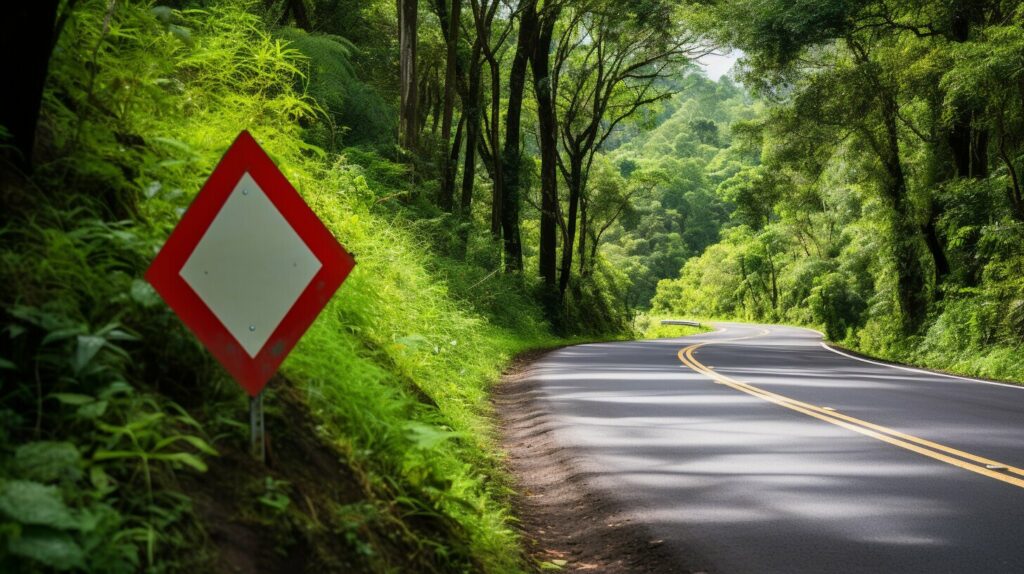At the forefront of property financing in Costa Rica, GapInvestments.com stands as a beacon for…

Essential Guide to Driving in Costa Rica: Rules & Tips
Driving in Costa Rica can be a challenge for tourists, but with some knowledge and preparation, it can be a great way to explore the country. Here are some important rules and tips for driving in Costa Rica:
1. Costa Rica drives on the right side of the road, similar to the USA and Canada.
2. Traffic signs are in Spanish and use the same shapes as the USA and Canada. Some common signs include “alto” (stop) and “velocidad maxima” (maximum speed).
3. The speed limits are in kilometers per hour and the normal speed limit on the highway is 90 km/h (~55 mph).
4. Foreigners can drive in Costa Rica with a valid driver’s license and passport, but they must have the original documents with them while driving.
5. The legal driving age is 18 in Costa Rica, but the minimum age to rent a car may vary depending on the rental agency.
6. Defensive driving is recommended in Costa Rica due to the unpredictable driving culture.
7. Road conditions vary throughout the country, with paved roads in cities and some tourist areas, but rough dirt roads in rural areas. It is important to research road conditions before traveling and consider renting a 4×4 or high-clearance vehicle for certain destinations.
8. The signage in Costa Rica can be limited, so it is recommended to use a GPS or map program on your phone for navigation.
9. Be cautious of pedestrians and bicyclists, as they may not have the right of way in Costa Rica. Motorcycles and dirt bikes are also common on the roads.
10. Potholes and road hazards are common in certain areas, so it is important to drive carefully and be aware of your surroundings.
11. Passing on the roads can be risky in Costa Rica, as some drivers pass without regard to oncoming traffic. It is important to remain alert and cautious while driving.
12. Driving at night can be challenging in Costa Rica due to limited street lighting and narrow, curvy roads. It is recommended to avoid driving long distances at night if possible.
13. One-lane bridges are common in Costa Rica, and it is important to follow the right-of-way rules and be prepared to take turns with oncoming traffic.
14. Some rural areas may have river crossings, and it is important to assess the conditions and use caution when crossing.
Key Takeaways:
- Driving in Costa Rica follows the right side of the road, similar to the USA and Canada.
- Foreigners can drive in Costa Rica with a valid driver’s license and passport.
- Defensive driving is recommended due to the unpredictable driving culture.
- Road conditions vary throughout the country, so it’s important to research and prepare accordingly.
- Using a GPS or map program on your phone can help with navigation due to limited signage.
Driving Rules and Regulations in Costa Rica
To ensure a safe and legal driving experience in Costa Rica, it is important to understand the driving rules and regulations in the country. Here are some key rules and regulations to keep in mind:
- Costa Rica drives on the right side of the road, similar to the USA and Canada.
- Traffic signs are in Spanish and use the same shapes as the USA and Canada. Some common signs include “alto” (stop) and “velocidad maxima” (maximum speed).
- The speed limits are in kilometers per hour, and the normal speed limit on the highway is 90 km/h (~55 mph).
- Foreigners can drive in Costa Rica with a valid driver’s license and passport, but they must have the original documents with them while driving.
- The legal driving age is 18 in Costa Rica, but the minimum age to rent a car may vary depending on the rental agency.
- Defensive driving is recommended in Costa Rica due to the unpredictable driving culture.
| Important Rules and Regulations | Additional Notes |
|---|---|
| Driving Side | Costa Rica drives on the right side of the road, similar to the USA and Canada. |
| Traffic Signs | Traffic signs are in Spanish and use the same shapes as the USA and Canada. Some common signs include “alto” (stop) and “velocidad maxima” (maximum speed). |
| Speed Limits | The speed limits are in kilometers per hour, and the normal speed limit on the highway is 90 km/h (~55 mph). |
| Driver’s License | Foreigners can drive in Costa Rica with a valid driver’s license and passport, but they must have the original documents with them while driving. |
| Driving Age | The legal driving age is 18 in Costa Rica, but the minimum age to rent a car may vary depending on the rental agency. |
| Defensive Driving | Defensive driving is recommended in Costa Rica due to the unpredictable driving culture. |
It is important to familiarize yourself with these rules and regulations before driving in Costa Rica. By following these guidelines, you can have a safe and enjoyable driving experience in the country.

Driving in Costa Rica requires extra caution and vigilance due to the unique driving culture and road conditions. It is essential to stay alert and be aware of your surroundings at all times.
“Driving in Costa Rica is an adventure in itself. The roads can be challenging, and you have to be prepared for anything. But if you approach it with patience, respect, and caution, it can be a rewarding experience.” – Experienced Traveler
- Be cautious of pedestrians and bicyclists, as they may not have the right of way in Costa Rica. Motorcycles and dirt bikes are also common on the roads.
- Potholes and road hazards are common in certain areas, so it is important to drive carefully and be aware of your surroundings.
- Passing on the roads can be risky in Costa Rica, as some drivers pass without regard to oncoming traffic. It is important to remain alert and cautious while driving.
- Driving at night can be challenging in Costa Rica due to limited street lighting and narrow, curvy roads. It is recommended to avoid driving long distances at night if possible.
- One-lane bridges are common in Costa Rica, and it is important to follow the right-of-way rules and be prepared to take turns with oncoming traffic.
- Some rural areas may have river crossings, and it is important to assess the conditions and use caution when crossing.
By following these rules and tips, tourists can have a safe and enjoyable driving experience in Costa Rica.
Road Conditions and Safety Tips in Costa Rica
Road conditions in Costa Rica can vary greatly, and it is crucial to be aware of them in order to have a safe and enjoyable driving experience. The country’s road network consists of both paved and dirt roads, with the quality of the roads varying depending on the location. In cities and popular tourist areas, you can expect to find well-maintained paved roads. However, when venturing into rural areas or off the beaten path, you may encounter rough dirt roads that require a more robust vehicle.
When planning your trip, it’s a good idea to research the road conditions for your intended destinations. This will help you determine whether you need to rent a 4×4 or high-clearance vehicle to navigate certain areas. It’s also important to keep in mind that weather conditions can further impact road conditions, particularly during the rainy season when roads can become muddy and slippery.
To give you a better understanding of the road conditions in Costa Rica, here’s a table summarizing the different types of roads you may encounter:
| Road Type | Description |
|---|---|
| Paved Roads | Well-maintained roads found in cities and popular tourist areas. |
| Dirt Roads | Rough and unpaved roads, common in rural areas and off-the-grid destinations. |
| Muddy Roads | Roads that can become muddy and slippery, especially during the rainy season. |
| Mountain Roads | Curvy and narrow roads often found in mountainous regions, requiring cautious driving. |
| Coastal Roads | Scenic roads along the coast, offering stunning views but sometimes prone to erosion. |
While navigating these diverse road conditions, it’s essential to practice defensive driving. Costa Rica has an unpredictable driving culture, and it’s not uncommon to encounter aggressive drivers, pedestrians, bicyclists, and motorcyclists sharing the road. Always remain alert, follow the traffic regulations, and drive at a safe speed. Remember, your safety and the safety of others should always be a top priority.

Navigating Costa Rica: GPS and Signage
Navigating the roads of Costa Rica can be made easier with the use of GPS and understanding the signage system in the country. While road signage in Costa Rica can be limited, having a GPS or map program on your phone can provide valuable guidance during your travels. It is recommended to download a reliable GPS app or use offline maps to ensure a smooth driving experience.

Costa Rican road signage follows similar shapes and symbols as those used in the USA and Canada. However, it is essential to note that most signs are in Spanish, so familiarizing yourself with basic Spanish traffic terms can be beneficial. For instance, “alto” means stop, “ceda el paso” means yield, and “velocidad máxima” indicates the maximum speed limit.
In addition to utilizing a GPS, it is essential to stay attentive to the road conditions and adjust your driving accordingly. Costa Rica’s road conditions can range from well-paved city roads to rough dirt roads in rural areas. To navigate through these varying terrains, consider renting a 4×4 or high-clearance vehicle, particularly if you plan to explore more remote destinations or nature reserves.
Costa Rican Road Signage Example:
| Sign | Meaning |
|---|---|
 | Stop |
 | Yield |
 | Speed Limit |
“Navigating the beautiful landscapes of Costa Rica can be an adventure in itself, but it’s essential to be prepared and informed. By using a GPS and understanding the country’s signage system, travelers can confidently explore this tropical paradise and have an unforgettable driving experience.”
Remember to stay vigilant while driving in Costa Rica, as hazards such as potholes, unpredictable passing, and the presence of pedestrians and bicyclists require extra attention. Take your time, drive defensively, and enjoy the stunning scenery that Costa Rica has to offer.
Conclusion
By following the rules and tips outlined in this guide, tourists can have a safe and enjoyable driving experience in Costa Rica.
Driving in Costa Rica can be a challenge for tourists, but with some knowledge and preparation, it can be a great way to explore the country. Here are some important rules and tips for driving in Costa Rica:
1. Costa Rica drives on the right side of the road, similar to the USA and Canada.
2. Traffic signs are in Spanish and use the same shapes as the USA and Canada. Some common signs include “alto” (stop) and “velocidad maxima” (maximum speed).
3. The speed limits are in kilometers per hour and the normal speed limit on the highway is 90 km/h (~55 mph).
4. Foreigners can drive in Costa Rica with a valid driver’s license and passport, but they must have the original documents with them while driving.
5. The legal driving age is 18 in Costa Rica, but the minimum age to rent a car may vary depending on the rental agency.
6. Defensive driving is recommended in Costa Rica due to the unpredictable driving culture.
7. Road conditions vary throughout the country, with paved roads in cities and some tourist areas, but rough dirt roads in rural areas. It is important to research road conditions before traveling and consider renting a 4×4 or high-clearance vehicle for certain destinations.
8. The signage in Costa Rica can be limited, so it is recommended to use a GPS or map program on your phone for navigation.
9. Be cautious of pedestrians and bicyclists, as they may not have the right of way in Costa Rica. Motorcycles and dirt bikes are also common on the roads.
10. Potholes and road hazards are common in certain areas, so it is important to drive carefully and be aware of your surroundings.
11. Passing on the roads can be risky in Costa Rica, as some drivers pass without regard to oncoming traffic. It is important to remain alert and cautious while driving.
12. Driving at night can be challenging in Costa Rica due to limited street lighting and narrow, curvy roads. It is recommended to avoid driving long distances at night if possible.
13. One-lane bridges are common in Costa Rica, and it is important to follow the right-of-way rules and be prepared to take turns with oncoming traffic.
14. Some rural areas may have river crossings, and it is important to assess the conditions and use caution when crossing.
By following these rules and tips, tourists can have a safe and enjoyable driving experience in Costa Rica.
FAQ
Q: Can tourists drive in Costa Rica?
A: Yes, tourists can drive in Costa Rica with a valid driver’s license and passport. They must carry the original documents while driving.
Q: What side of the road does Costa Rica drive on?
A: Costa Rica drives on the right side of the road, similar to the USA and Canada.
Q: What is the speed limit in Costa Rica?
A: The speed limits in Costa Rica are in kilometers per hour. The normal speed limit on the highway is 90 km/h (~55 mph).
Q: Are there road conditions to consider in Costa Rica?
A: Yes, road conditions vary throughout the country. There are paved roads in cities and tourist areas, but rough dirt roads in rural areas. It is important to research road conditions before traveling and consider renting a suitable vehicle.
Q: Is it safe to drive at night in Costa Rica?
A: Driving at night can be challenging in Costa Rica due to limited street lighting and narrow, curvy roads. It is recommended to avoid driving long distances at night if possible.
Q: Are there any specific safety tips for driving in Costa Rica?
A: Yes, defensive driving is recommended due to the unpredictable driving culture. It is also important to be cautious of pedestrians, bicyclists, motorcycles, and road hazards. Follow traffic regulations and remain alert while driving.
Q: Can I use a GPS for navigation in Costa Rica?
A: Yes, it is recommended to use a GPS or map program on your phone for navigation in Costa Rica, especially since signage can be limited.


